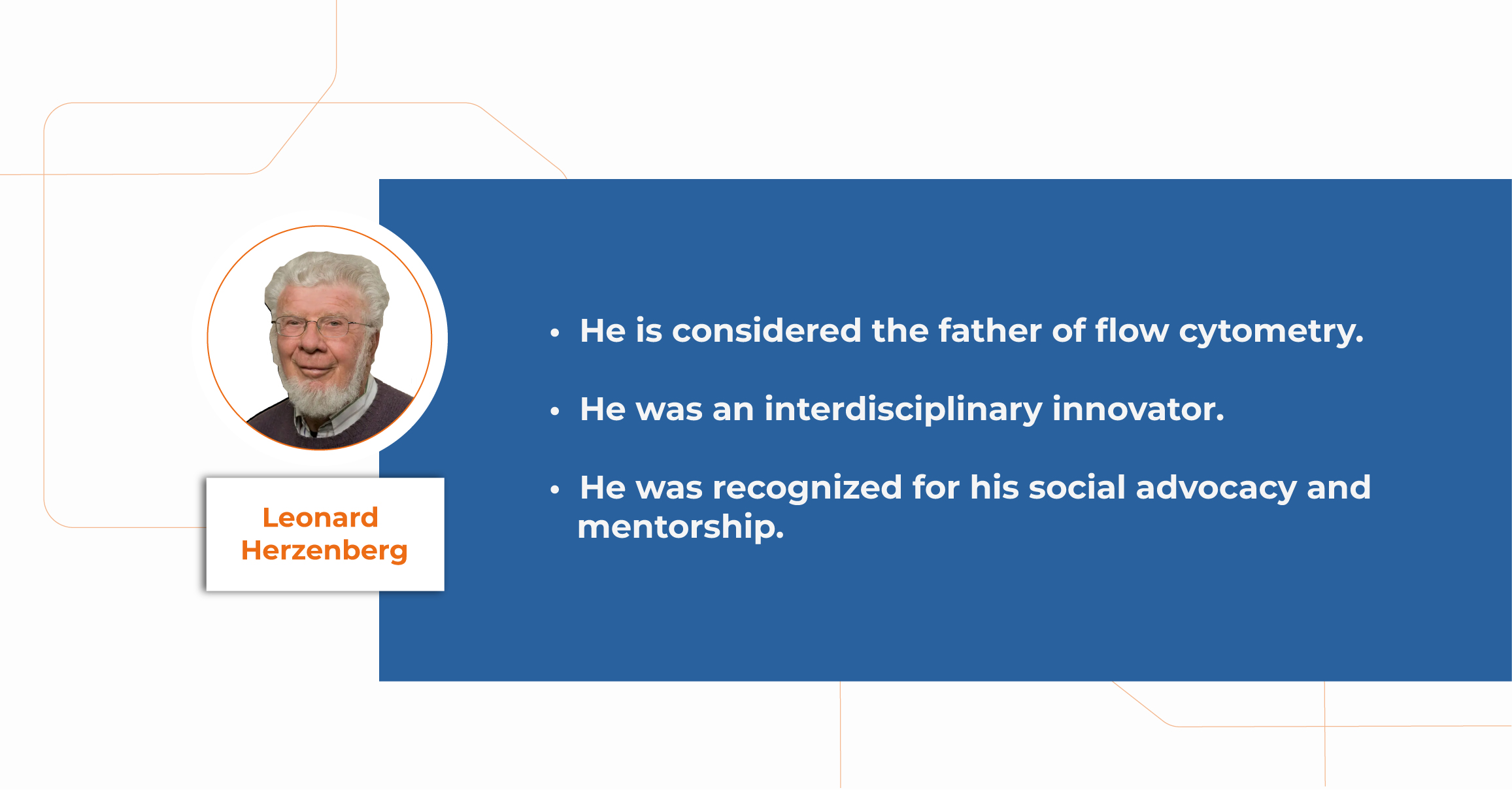Leonard Herzenberg: The father of modern flow cytometry
- He is considered the father of flow cytometry.
- He was an interdisciplinary innovator.
- He was recognized for his social advocacy and mentorship.

Leonard Herzenberg was one of the most influential immunologists of his time. Committed to interdisciplinary collaboration and innovation, he would bring together physicists, biologists, and clinicians to tackle some of the most challenging questions in immunology. His pioneering groundwork laid the foundation for countless advancements in immunology, cell biology, and medical diagnostics. Alongside his wife Leonore Herzenberg, his contributions left an indelible mark on scientific research and medical practice.
Early life, an innate curiosity for science coupled with a dedication to learning
Leonard Herzenberg was born in 1931 in New York City; growing up during the Great Depression shaped him, influencing his worldview and lending him a deep sense of social responsibility. From a young age, Leonard displayed a keen interest in science and mathematics, attending Stuyvesant High School in New York City, known for its focus on science and technology. His passion for science only grew, and after earning his bachelor’s degree from Brooklyn College in 1952, he began his doctoral studies in Pasadena, California, at the California Institute of Technology. After finishing his PhD, he soon moved to Paris, France for a fellowship at the Pasteur Institute with biologist and Nobel laureate Jacques Monod. He then moved to Bethesda, Maryland, to work for the United States National Institutes of Health (NIH), where he served as an officer in the Public Health Service.
The birth of Flow Cytometry
After his time in Maryland, Leonard Herzenberg returned to California, this time to Stanford University. It was there that he made, alongside his wife, their first groundbreaking contribution to the field of immunology: Fluorescence Activated Cell Sorting (FACS).
There was an unmet need for a high-throughput, automated method for the enumeration and separation of rare cells in large populations. He formed a cross-functional team composed of engineers and biologists to improve a particle-sorting machine, adding techniques to detect fluorescence and manipulate droplets. They leveraged advances in flow sorting of cell-sized particles by Mack Fulwyler alongside oscillatory ink-jet printing techniques pioneered by Richard Sweet. They seized on the visionary concept of building an instrument capable of rapidly identifying and sorting live cells with distinctive surface molecules detected by fluorescently tagged antibodies. The result was FACS, a pioneering method of sorting cells that revolutionized cell biology and medicine.
The implications of this development were immense, allowing researchers to isolate and study different cell types with an unprecedented level of precision. Remarkably, FACS has remained fundamentally unchanged since its invention.
Monoclonal antibodies and the development of hybridoma technologies
Herzenberg’s laboratory played a pivotal role in introducing hybridoma technology to the US following his sabbatical in Cesar Milstein’s laboratory. His team isolated many of the initial monoclonal antibodies against human and mouse leukocytes, laying the foundation for extensive research in subsequent decades. The laboratory’s contributions extended to defining major histocompatibility complex (MHC), understanding the functions and differentiation of B cell and T cell subsets, and advancing the genetics of mouse immunology.
Passionate about his causes
Leonard Herzenberg’s passions expanded beyond science; he was a vocal advocate for numerous sociopolitical causes. He was a dedicated supporter of the efforts to promote equality for women and minorities in the scientific community, establishing (along with his wife, Leonore) programs to bring disadvantaged youth to Stanford to learn about medical research. Additionally, he was outspoken in his condemnation of the eugenics movement and nuclear proliferation; and in his later years rallying against the stigmatization of people with HIV.
A long-lasting impact
Leonard Herzenberg’s career significantly influenced biomedical science research and application, leading to numerous honors, including his election to the NAS in 1982 and the prestigious 2006 Kyoto Prize.
His contributions throughout his career shaped numerous aspects of modern science.
Today, these efforts are seen in various clinical applications such as CD4+ T-cell monitoring in HIV, leukemia classification, tumor staging, stem cell isolation for transplantation, and monitoring bone marrow transplant progress. The therapeutic use of Mabs for autoimmune diseases, organ transplantation rejection, and cancer owes much to FACS technology and the use of monoclonal antibodies.
Outside of his own research, Leonard Herzenberg left his mark on future scientists through his mentorship work. His collaborative spirit, teaching, and guidance has influenced generations of scientists, with many of his students and colleagues having gone on to provide their own significant contributions to immunology and cytometry.
Leonard Herzenberg passed away in 2013 at the age of 81, but his legacy has remained. His profound impact on scientific research and medical practice underscores his significance as a visionary and trailblazer in the field of biotechnology.
Recommended Sources for Digging Deeper
- Dangl JL, Lanier LL. Founding father of FACS: Professor Leonard A. Herzenberg (1931–2013). Proc Natl Acad Sci U S A. 2013 Dec 24;110(52):20848-9. doi: 10.1073/pnas.1321731111. PMID: 24344298; PMCID: PMC3876245.
- Hardy RR, Roederer M. Leonard Herzenberg (1931-2013): the life of FACS. Immunity. 2013 Dec 12;39(6):989-91. doi: 10.1016/j.immuni.2013.11.008. PMID: 24479158.

